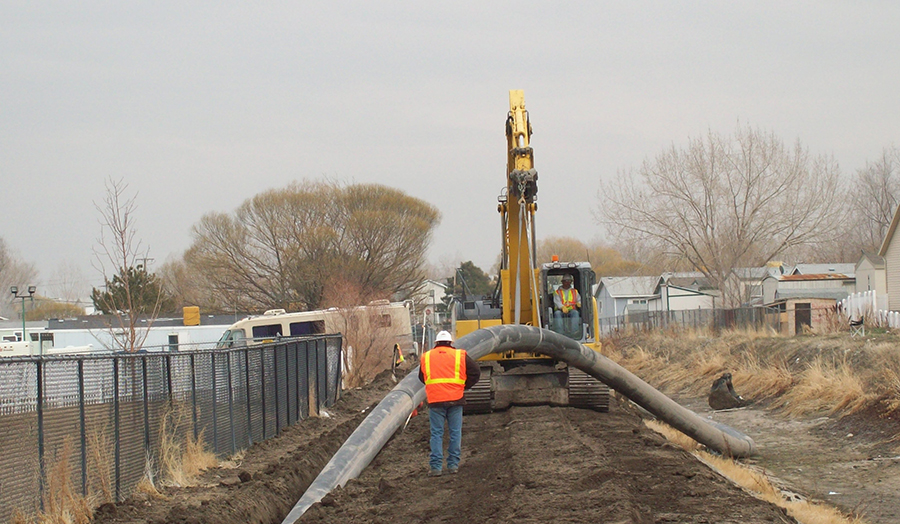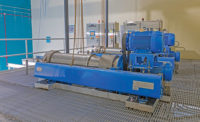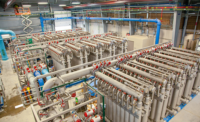The Jordan Valley Water Conservancy District is nearing the finish line of an engineering marathon that has gone on for almost 30 years. At the end of November, crews from COP Construction, a utility and infrastructure building firm headquartered in Billings, Mont., placed the final 2,000 ft of 16-in. to 18-in. pipe from a retention pond on the outskirts of the Bingham Canyon (aka Kennecott) copper mine leading into the Great Salt Lake.
The new line will discharge byproduct from one of the largest reverse osmosis groundwater treatment projects in the U.S.
The $74-million Southwest Jordan Valley Groundwater Treatment Project is the result of a public-private partnership between the Jordan Valley Water Conservancy District (JWCD) and London-based Rio Tinto, the current owners and operators of the Bingham Canyon mine formerly operated by Kennecott Utah Copper.
The project is designed to purify groundwater contaminated by decades of mine wastewater leaching from unlined containment ponds and tailings dumps. The Bingham Canyon mine is one of the largest open-pit mines in the world. It began production in 1906. The plumes, one near the Bingham Canyon mine (Zone A) and the other (Zone B) farther east, were gradually moving toward the Jordan River, which bisects the Salt Lake Valley and empties into the Great Salt Lake.
The plumes would eventually contaminate aquifers that contribute about 25,000-acre ft of water to a system serving nearly 600,000 residents in cities at the southwest corner of the Salt Lake Valley.
“It is a good solution from the perspective of what needed to be accomplished,” says Doug Bacon, an environmental scientist from the Utah State Dept. of Environmental Quality. “We knew the plumes were a hazard, and we also knew we needed that drinking water for a quarter of the people in the Salt Lake Valley.”
Potential Contamination
The contaminant plumes were identified by state environmental regulators in the late 1980s. Negotiations with Kennecott eventually resulted in the company agreeing to compensate the state of Utah for the loss of the water resource.
But Alan Packard, assistant general manager and chief engineer for the JWCD, says it did not solve the problem of the contamination tainting more aquifers as it moved toward the Jordan River.
“About 10 to 20% of our water comes from ground sources. The vast majority of our wells are outside the plumes, but if the plumes were left unchecked, it would have moved east and north toward the river,” Packard says. “It wouldn’t have affected our active wells, but we have water rights to wells further north, and the wells of some of our member agencies would have been affected. Kennecott was going to pay the state for the loss of the water and be done with it.
“We came in in 1990 and said we could contain the polluted groundwater and put it to use,” he adds. “I think we were looked at as a nuisance at the time, but we were persistent and eventually convinced both parties this was a good idea. Kennecott has become a very good partner in this.”
Barrier Wells
The Boise office of Carollo Engineers was hired to develop a solution for JWCD. Tom Seacord, Carollo’s vice president and chief desalinization technologist, says his team devised a system of seven 12-in.-diameter barrier wells drilled into the plumes at depths ranging from 400 to 1,000 ft. The contaminated water is then pumped to two RO treatment facilities and then added to the district’s culinary water system.
Project engineers say what looked like a fairly standard groundwater treatment project came with a host of challenges. Chris Mikell, a hydrogeologist and project manager from Sandy, Utah-based subconsultants Bowen Collins & Associates, was tasked with designing the wells.
“With the RO treatment, there is a concern with corrosion of the pipes and getting metals in the water (iron can seriously damage RO membranes),” he says. “So the wells are constructed with fiberglass casings and the pipe is all HPE.”
Metal fittings on the pipe were replaced with plastic, and all other metal parts in the system are coated with plastic, Mikell says.
“We also had a requirement that we could not produce any sand from the wells,” he adds. “We made the wells sand free. We have a screen engineered to prevent sand particles getting though as well as an artificial gravel pack around the screen. Then there are several levels of pretreatment at the plant site before the water goes into the RO.”
Seacord says the Bingham Canyon Water Treatment plant, built and operated by Kennecott, began processing about 3,500-acre ft of groundwater in 2006, discharging byproduct into containment ponds and reusing it in mining operations. But the West Jordan facility had more complexity, including taking the RO water and putting it through a finishing stage, and did not begin operating until 2013.
“It took us longer to design our process than we anticipated,” says Packard.
The West Jordan plant produces approximately 4,700-acre ft of culinary water per year and was allowed to temporarily discharge into the tailings ponds while officials looked at several options for disposing of the byproduct.
“The concentrate disposal issues were the greatest challenge of the project,” Seacord says. Every four gallons of water processed results in one gallon of byproduct or water with concentrated levels of selenium and sulfides among other potentially toxic materials.
Long, Winding Pipeline
“We looked at a disposal into the Jordan River, and the state issued a permit that would allow that. But the district didn’t get into this to be the bad guys, and putting the byproduct into the river didn’t seem like the best option, so the permit was withdrawn, and we started to look at the pipeline out to the tailings ponds to the Great Salt Lake,” Seacord says.
In order for the concentrate to be emptied in the Great Salt Lake, Bacon says that state regulators performed a four-year study of the potential effects on the lake. Regulators concluded that as long as selenium levels remained below 12.5 parts per million, there should be no significant effect on the many waterfowl that live along the shoreline.
A permit was granted to the JWCD, but the area will still be monitored by regulators as the system begins operating at full capacity by the end of this year, putting about 1.5 million gallons of byproduct water into the lake each day.
Getting the byproduct water to the Kennecott ponds, and now to the new Great Salt Lake discharge line, required a 21-mile pipeline that would have to pass through several cities.
Keith Larson, the Bowen Collins project manager for the pipeline, says that while studying routes, the team happened on an unexpected but convenient solution. The existing Utah-Salt Lake canal, an open channel secondary water system, runs along nearly the same route the pipeline would have to take.
“We were able to place about 60% of the pipeline in the canal right-of-way, right in the access road,” says Larson. “It cut our total length down significantly, and we were able to avoid a lot of issues with digging up streets, conflicts with other utility lines and traffic control.”
Larsen says that because the pipe would be carrying water with high mineral content, it had to be made resistant to building up.
“We have 16- and 18-in. HDPE pipe. It is resistant to scale. We have minimal joints in the pipe, and the joints are fused with the interior bead removed so it is smooth. We have some really long runs with minimal couplings,” Larson adds. “We also needed to limit air to water interfaces so we have no open channels and we’ve got a back-pressure vault at the end of the line to keep the pressure up and the air out.”
Keeping the line pressurized was also key for the pigging system that’s used to regularly clean the pipeline. “The back-pressure vault is also a pig retrieval vault,” says Larson. “For this sized project, the vault is kind of oversized, but it is because we have an oversized sleeve with a cage inside that can hold about four pigs. The vault is designed so the pigs can be retrieved without losing pressure.”
The final stage of the pipeline will run from the tailings ponds, under Interstate 80 and into the Great Salt Lake.
“The pipe will be anchored to the lake bottom and will end at a discharge structure under the water,” says Jasen Bennie, Utah area manager for COP Construction. “We’ve got concrete pipe anchors holding the pipe and we’ll encase the entire line with concrete before we’re done.”
Project officials say the entire system should be fully operational before the end of the year. It’s expected to take nearly 40 years to clean both plumes of contamination.




Post a comment to this article
Report Abusive Comment